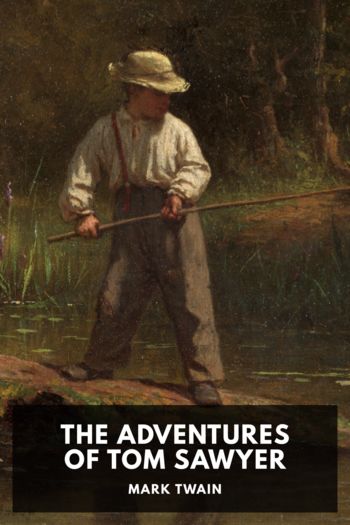The Autobiography of Mark Twain Mark Twain (best beach reads .TXT) 📖

- Author: Mark Twain
Book online «The Autobiography of Mark Twain Mark Twain (best beach reads .TXT) 📖». Author Mark Twain
Most of the houses were of logs—all of them, indeed, except three or four; these latter were frame ones. There were none of brick, and none of stone. There was a log church, with a puncheon floor and slab benches. A puncheon floor is made of logs whose upper surfaces have been chipped flat with the adz. The cracks between the logs were not filled; there was no carpet; consequently, if you dropped anything smaller than a peach, it was likely to go through. The church was perched upon short sections of logs, which elevated it two or three feet from the ground. Hogs slept under there, and whenever the dogs got after them during services, the minister had to wait till the disturbance was over. In winter there was always a refreshing breeze up through the puncheon floor; in summer there were fleas enough for all.
A slab bench is made of the outside cut of a saw-log, with the bark side down; it is supported on four sticks driven into auger holes at the ends; it has no back and no cushions. The church was twilighted with yellow tallow candles in tin sconces hung against the walls. Week days, the church was a schoolhouse.
There were two stores in the village. My uncle, John A. Quarles, was proprietor of one of them. It was a very small establishment, with a few rolls of “bit” calicoes on half a dozen shelves; a few barrels of salt mackerel, coffee, and New Orleans sugar behind the counter; stacks of brooms, shovels, axes, hoes, rakes, and such things here and there; a lot of cheap hats, bonnets, and tinware strung on strings and suspended from the walls; and at the other end of the room was another counter with bags of shot on it, a cheese or two, and a keg of powder; in front of it a row of nail kegs and a few pigs of lead, and behind it a barrel or two of New Orleans molasses and native corn whisky on tap. If a boy bought five or ten cents’ worth of anything, he was entitled to half a handful of sugar from the barrel; if a woman bought a few yards of calico she was entitled to a spool of thread in addition to the usual gratis “trimmin’s”; if a man bought a trifle, he was at liberty to draw and swallow as big a drink of whisky as he wanted.
Everything was cheap: apples, peaches, sweet potatoes, Irish potatoes, and corn, ten cents a bushel; chickens, ten cents apiece; butter, six cents a pound; eggs, three cents a dozen; coffee and sugar, five cents a pound; whisky, ten cents a gallon. I do not know how prices are out there in interior Missouri now, but I know what they are here in Hartford, Connecticut. To wit: apples, three dollars a bushel; peaches, five dollars; Irish potatoes (choice Bermudas), five dollars; chickens, a dollar to a dollar and a half apiece, according to weight; butter, forty-five to sixty cents a pound; eggs, fifty to sixty cents a dozen; coffee, forty-five cents a pound; native whisky, four or five dollars a gallon, I believe, but I can only be certain concerning the sort which I use myself, which is Scotch and costs ten dollars a gallon when you take two gallons—more when you take less.
Thirty to forty years ago, out yonder in Missouri, the ordinary cigar cost thirty cents a hundred, but most people did not try to afford them, since smoking a pipe cost nothing in that tobacco-growing country. Connecticut is also given up to tobacco raising, today, yet we pay ten dollars a hundred for Connecticut cigars and fifteen to twenty-five dollars a hundred for the imported article.
At first my father owned slaves, but by and by he sold them and hired others by the year from the farmers. For a girl of fifteen he paid twelve dollars a year and gave her two linsey-wolsey frocks and a pair of “stogy” shoes—cost, a modification of nothing; for a negro woman of twenty-five, as general house servant, he paid twenty-five dollars a year and gave her shoes and the aforementioned linsey-wolsey frocks; for a strong negro woman of forty, as cook, washer, etc., he paid forty dollars a year and the customary two suits of clothes; and for an able-bodied man he paid from seventy-five to a hundred dollars a year and gave him two suits of jeans and two pairs of “stogy” shoes—an outfit that cost about three dollars. But times have changed. We pay our German nursemaid $155 a year; Irish housemaid, $150; Irish laundress, $150; negro woman, a cook, $240; young negro man, to wait on door and table, $360; Irish coachman, $600 a year, with gas, hot and cold water, and dwelling consisting of parlor, kitchen, and two bedrooms, connected with the stable, free.3
The Grant Dictations1885
The Chicago G.A.R. FestivalDictated in 1885
The first time I ever saw General Grant was in the fall or winter of 1866 at one of the receptions at Washington, when he was general of the army. I merely saw and shook hands with him along with the crowd, but had no conversation. It was there, also, that I first saw General Sheridan.
I next saw General Grant during his first term as President. Senator Bill Stewart, of Nevada, proposed to take me in and see the President. We found him in his working costume, with an old, short, linen duster on, and it was well spattered with ink. I had acquired some trifle of notoriety through some letters which I had written, in the New York Tribune, during my trip round about the world in the Quaker City expedition. I shook hands, and





Comments (0)